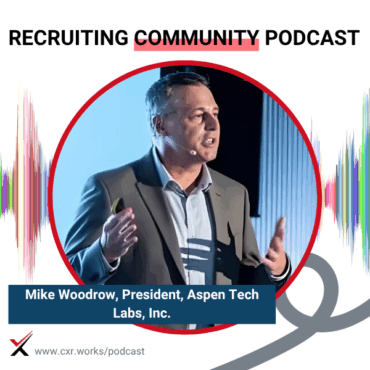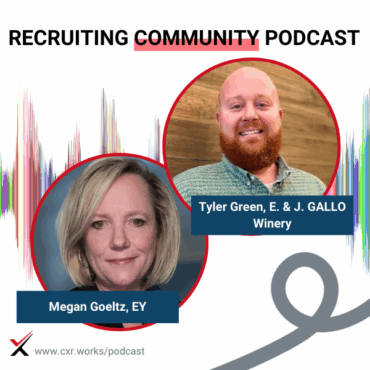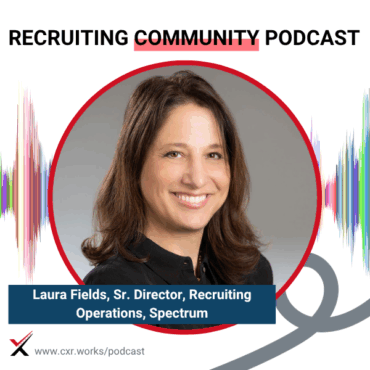
Assessments and Candidate Experience
What if self-affirmation could boost assessment completion rates? Laura Fields shares how psychology-based emails helped Spectrum win back strong candidates.
 play_arrow
play_arrow
Balancing Strategy and Tactics: Melissa Thompson’s Career Crossroads Cami Grace
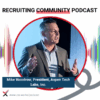 play_arrow
play_arrow
Real-Time Jobs Data and the TA Advantage Cami Grace
 play_arrow
play_arrow
20+ Years at Dell and Beyond: Jennifer Newbill’s Career Crossroads Cami Grace
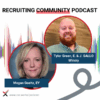 play_arrow
play_arrow
AI Interview Research Cami Grace
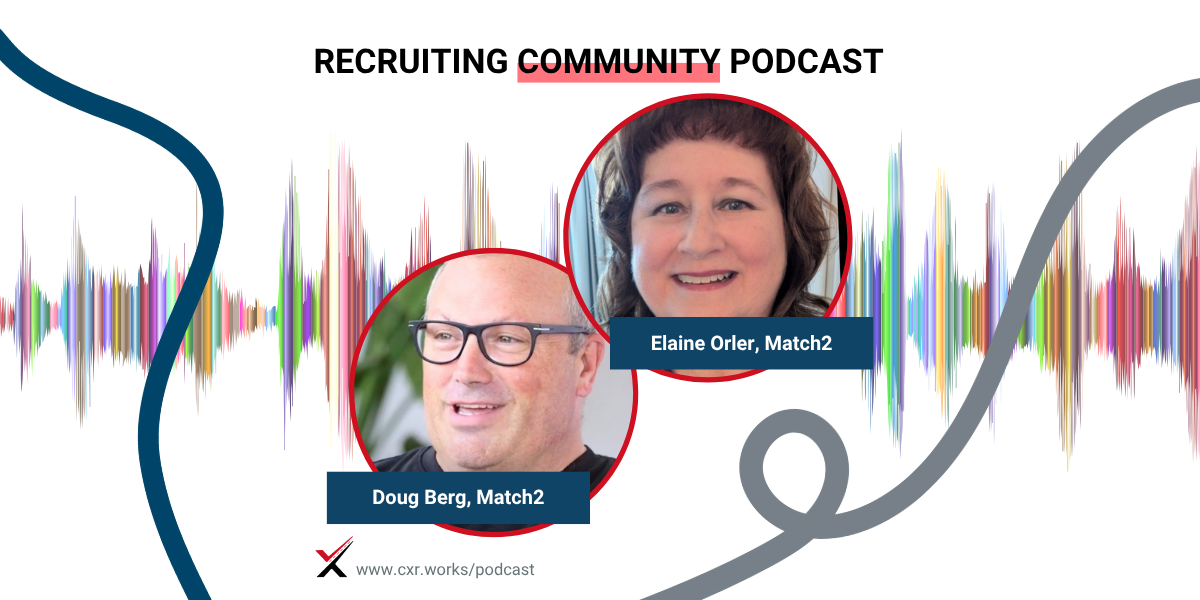
The way candidates search for jobs is changing, and Match2 is leading the charge. In this episode, we sit down with Doug Berg and Elaine Orler, two legends in the talent tech space, to discuss how their latest innovation is transforming the job search and hiring experience. Instead of forcing candidates to sift through endless job postings, Match2 flips the process—matching jobs to candidates based on their skills and experience, creating a more personalized and engaging hiring journey.
Doug and Elaine dive into the inspiration behind Match2, the power of AI-driven job discovery, and how this technology is eliminating hiring inefficiencies for both recruiters and job seekers. If you’re looking to improve candidate experience, boost conversion rates, and finally capture passive talent, this episode is packed with must-hear insights.
[3:30] – The problem with traditional job search and why it needed a fix
[8:45] – How AI-powered job matching is changing candidate engagement
[15:20] – Reducing hiring inefficiencies: The recruiter’s perspective
[22:10] – The impact of better job discovery on employer branding and recruitment marketing
[29:35] – What’s next for Match2 and the future of AI in hiring
[36:50] – Why investing in candidate experience today will pay off in 2025 and beyond
If you found this conversation insightful, don’t forget to subscribe, rate, and leave a review! Follow us for more expert discussions on the future of talent acquisition, AI-driven hiring, and employer branding. See you next time!
Title:
The Story Behind a New TA/Candidate Experience
Featured Guests:
Doug Berg, Co-Founder, Match Two
Elaine Orler, Co-Founder, Match Two
Hosts:
Chris Hoyt, President, CareerXroads
Gerry Crispin, Co-Founder, CareerXroads
Episode Overview:
Chris Hoyt and Gerry Crispin sit down with Doug Berg and Elaine Orler to explore how Match Two is transforming the job application process. The conversation highlights how AI is being used to reverse the job search, match candidates more intelligently, and build long-term engagement. The guests share insights on practical use cases, internal mobility, and the value of real-time candidate feedback in shaping future hiring.
Key Topics:
The origin story and evolution of Match Two
Shifting from job search to job matching using OpenAI
Improving candidate experience through interactivity and personalization
Use cases in passive candidate capture and internal mobility
Employer insights on job post performance and candidate behavior
Enhancing transparency, engagement, and long-term relationships
The ease of implementation and impact across disparate ATS environments
Notable Quotes:
“AI without curation isn’t personalization.” — Doug Berg
“This is a solution that gives candidates something to do on the site that’s meaningful and relevant to their career.” — Elaine Orler
“If you’re using Match Two, there are expectations. Candidates will get feedback, closure, transparency.” — Gerry Crispin
“TA leaders know they’ve built systems that screen candidates out. We’re helping to correct that.” — Doug Berg
Takeaways:
Match Two enables organizations to flip the traditional recruiting model, using AI to present jobs that match candidate profiles before they even apply. With fast, lightweight integration and an emphasis on interaction and data ownership, the platform supports better candidate engagement, improved employer branding, and smarter decision-making. Its value extends across professional roles and internal mobility initiatives, offering a scalable way to build lasting candidate relationships.
Want more conversations like this?
Subscribe to the CXR podcast and explore how top talent leaders are shaping the future of recruiting. Learn more about the CareerXroads community at cxr.works.
Chris Hoyt: Do you guys remember Sean Shepherd?
Doug Berg: Mm-hmm. Yes.
Chris Hoyt: How could you not? He’s quite a character, right? Brilliant guy. Heck of a golfer. In a weird twist of fate, he and his wife are renting a house just outside of Austin, Texas, to get away from the cold. Ironically, it was in the 50s and 40s last night. They’re renting this house for a while, so we met them last night for drinks—went to a pizza place out in Bastrop called Neighbors. Great pizza place.
Well, we got cut off at 8 o’clock.
Too loud, too rowdy. Nobody was overserved, but I think we might’ve been a little loud. The very timid waitress—we’ll call her “fine”—was a little intimidated by how loud we were. Bastrop is not exactly highfalutin; it’s a bit more of a country, low-key atmosphere. Sean posted about it last night with a picture: “What two guys get cut off at a pizza joint at 8 o’clock?”
So, can anybody beat that? Ever been cut off? We didn’t get booted, but there wasn’t going to be any more alcohol. So we left.
Doug Berg: You were probably wearing your “Legalize Marinara” shirt.
Chris Hoyt: Is that a shirt? Where do I get a “Legalize Marinara” shirt?
Doug Berg: There’s a pizza place in Cabo where that’s what they all wear. “Legalize Marinara.” It’s hilarious.
Chris Hoyt: I would absolutely love that. I’d wear it every day, maybe. Cut off at 8 o’clock. That’s great.
Had to get pizza—doing it right. But they’re lovely. His wife is quite lovely, and it was kind of fun to catch up with them. But yeah, cut off at 8 o’clock. Terribly embarrassing.
All right, are we ready to go? We’ve got some cool stuff to talk about today. You guys are doing some cool things.
Doug Berg: Thank you. I’m ready.
Chris Hoyt: Okay, let’s do it. Here we go.
Announcer: Welcome to the CXR channel, our premier podcast for talent acquisition and talent management. Listen in as the CXR community discusses a wide range of topics focused on attracting, engaging, and retaining the best talent. We’re glad you’re here.
Chris Hoyt: Welcome to the Recruiting Community Podcast, where we’re bringing insights and updates in what we think is a fun conversation—it’s fun for us, anyway. All brought to you, of course, by the CareerXroads community. As a reminder, this is a labor of love. Nobody pays to play. You’re here because you’re a friend of the community, doing cool stuff, and we just want to hear what you have to say.
Today, Jerry and I are bringing in Doug Berg and Elaine Orler, longtime friends of ours, now from Match Two. We’re going to talk about the story behind Match Two—what it is and how that solution is ideally changing how candidates interact with jobs.
First, a little housekeeping. We’re streaming on social—YouTube, Facebook, LinkedIn, Twitch. If you’re with us on LinkedIn, chime in on the chat, say hello, and if you’ve got questions for Doug or Elaine, throw those in too. If you want to see past episodes or learn about future ones, head to cxr.org/podcast.
Jerry, did I miss anything?
Gerry Crispin: No, I think you’ve got it all.
Chris Hoyt: All right. I feel good about that. Let’s bring them in. It’s like a little mini-reunion. How are you guys doing?
Elaine Orler: Really good. Feels like family time—hometown home week. That’s what it feels like today.
Doug Berg: Resisting the urge to open a bottle of red wine.
Chris Hoyt: Did we ever do an Uncorked podcast with you?
Doug Berg: I think we did.
Gerry Crispin: We did one, yeah. In Minneapolis, if I remember right. We need to bring that back.
Chris Hoyt: Jerry, do we need to bring that back?
Gerry Crispin: We do.
Chris Hoyt: Okay, I might be talked into that. Dry January’s over. Lyft rides are up. Everybody’s back to drinking and doing what they normally do. Sure, why not?
So, for folks who haven’t had the pleasure of getting to know either of you—Doug, I’ll pick on you first. You’re kind of on the left side of my Brady Bunch grid here. Give us an escalator pitch. You’ve got a long history in the space—give us a little history and stop at the Match Two point.
Doug Berg: I’m Doug Berg. I’ve been building talent tech for over 30 years. I started my career writing assembly language on IBM mainframes. Eventually, I got recruited into a headhunting firm because I was “a geek who could speak,” and that’s how I got into recruiting.
I worked a desk, built up a consulting and staffing group of about 100 people here in Minneapolis. I brought the first PC into that firm and built the first database—really started using tech for recruiting from the beginning.
When the internet hit, I started a job board called techies.com. We became the number one site for tech professionals, which taught me a lot about candidate experience and how recruiters use technology. We almost IPO’d, but the market crashed in April 2000.
Later, I started Jobs2Web—an early recruitment marketing platform that layered on top of ATSs. That was acquired, and I went on to build ZapInfo, a recruiter productivity tool that was acquired by Indeed. At Indeed, I helped connect them to the entire talent ecosystem.
And now, here we are—Match Two.
Chris Hoyt: I love it. I think we met in your early Jobs2Web days. You’ve always been building for recruiters. Just a joy to watch.
Doug Berg: A lot of people think I’m some kind of innovator, but I’m more of an interpreter. Practitioners have the ideas. My job’s just to dig them out and make them happen.
Chris Hoyt: You’re like the recruiting Rosetta Stone.
Doug Berg: If it teaches me a new language, I’ll be happy.
Chris Hoyt: Elaine, how about yourself?
Elaine Orler: Parallel in years and experience. I started at Qualcomm with a platform called REX—most people won’t remember that unless you’ve been around as long as we have. From there, I moved into consulting, working on TA strategy, process design, and tech enablement.
I launched Talent Function in 2009, eventually sold it to Cielo. I also co-founded the Talent Board and Candidate Experience Awards with Gerry. We took that global. Later, I acquired a software company, rebranded it as TA.Vista, and sold that to Clovers AI.
I’ve always focused on candidate experience and finding solutions that fit real-world problems.
Chris Hoyt: Love it. And yes, we did take a helicopter ride. Doors off!
Elaine Orler: Doors off! I’ll never do it again, but I did it once.
Chris Hoyt: Jerry’s shaking his head, but it was a wonderful trip.
Let’s get into it. Doug, why don’t you give us the pitch behind Match Two. Where did the idea come from?
Doug Berg: Sure. Two entrepreneurs from Minneapolis approached me with an idea: using OpenAI to match resumes to jobs. Originally, they wanted to sell it to candidates, but I knew from experience that’s a tough market. Instead, I saw the opportunity to bring this to TA leaders—to reverse the job search process and make jobs match to candidates.
I tested the idea with TA leaders. They all said they were getting too many unqualified candidates and not enough qualified ones. Many said they wished they could hide the job search and instead capture candidate info first, then show matching jobs. That’s exactly what Match Two does.
We’re solving multiple problems: capturing passive traffic, reducing unqualified applicants, giving candidates a voice, and making the application more intelligent and interactive. We want to stop the cycle of paying for the same talent over and over. Match Two is a drop-in technology—fast to implement and transformative.
Chris Hoyt: I love it. I love the spirit of that too. And so, Elaine, now I’ve got to go to you. When Doug rings you up and says, “Hey, I’ve got an idea,” what was it that made you say, “I’ve got to be part of this”?
Elaine Orler: It started with, “Hey Elaine, it’s Doug,” and I was already in. But seriously, for me, it’s about the candidate experience and the interactivity. This is a solution that gives candidates something to do on the site that’s meaningful and relevant to their career. Instead of the hope-and-pray search-and-apply process, now they can load their resume quickly, interact with it, and see where they truly fit.
One of my favorite examples—how many senior financial analysts list “advanced Excel” on their resume? Not many. But it’s a required skill in most job descriptions. This allows candidates to say, “Wait, I do have that skill,” and advocate for themselves.
Another big shift for me was the return-visit personalization. Instead of starting from scratch, they come back and get, “Hey, two new jobs match your profile.” That changes the game in terms of how we carry candidate relationships forward.
Gerry Crispin: What’s fascinating to me is now you’re in a position to really ask candidates what they’re getting out of this experience that they aren’t getting elsewhere. That’s key to growth and engagement.
Elaine Orler: Absolutely. Through the Connected Talent Network, we can keep that relationship going. Candidates keep control of their data, and we get better insights—like if they accepted another job, where they went, and why. That feedback loop is huge.
Chris Hoyt: I find that polling component really powerful. Is it too early to see macro trends from candidates? And are you getting any early indicators of how current events are influencing their decisions?
Doug Berg: It’s early—we’re still in beta with several companies. But what’s interesting is the level of experimentation we’re enabling. With a single script, we can activate the entire solution on any career site and start testing different experiences.
For example, we worked with Mayo Clinic years ago. They were spending tons of money trying to attract physicians to their site, but few would apply. I was the guy saying, “Why is ‘Apply’ the only way to show interest?” We’re bringing back that flexibility—letting candidates express curiosity or raise their hand without committing to a full application.
Chris Hoyt: And with the AI layer, you’re not just recommending jobs—you’re curating the entire journey.
Doug Berg: Exactly. AI without curation isn’t personalization. We’re allowing candidates to engage, respond, and control their path forward. Whether it’s interview scheduling, recruiter messages, or skills they forgot to list—we’re building a two-way street. And yes, we track all of this to give employers actionable insights on what requirements are blocking candidates, how they can adjust job posts, and even go back and re-engage missed talent.
Chris Hoyt: That ties directly into employer branding. This can give insights to help adjust messaging based on how candidates respond—or don’t.
Doug Berg: Yes. We’re capturing every match event. For example, if a job requires a CS degree and 150 candidates bounced because of it, now you know. If you change the requirement, we can even go back to those 150 and say, “Hey, it’s been updated.”
Chris Hoyt: That’s powerful.
Doug Berg: It also lets us do competitive insights. Like, what other sites did candidates visit after yours? Where else are they applying? How long does it take you to get from application to interview compared to others? All compliant, all opt-in—but valuable.
Chris Hoyt: I’m loving the potential here. Are there specific personas or job types where this solution performs best?
Doug Berg: It works best where there’s some depth to the resume and the job requirements. For high-volume, no-resume roles, a chatbot is still probably the better option. But for professional roles—tech, finance, healthcare—it really shines.
Elaine Orler: And it’s getting great early interest for internal mobility, too. Companies don’t want to buy another platform. They just want a better way for employees to see what roles they match, today or in the future. The AI helps with that career projection.
Doug Berg: Right. And imagine tying that into your current application experience—telling external candidates not just what they qualify for now, but what their path looks like inside the company.
Chris Hoyt: Love it. You two have packed so much thought into this. What’s next? What should people be watching for?
Elaine Orler: We’ll be out at events. If you see us, stop by. The biggest thing is the drop-in simplicity. You don’t have to rip and replace your whole tech stack. This is lightweight, fast, and delivers immediate value.
Chris Hoyt: That’s huge. We just launched a soft rollout of RecruitingJobs.cxr.works. I think something like this would help the recruiters using it. Let’s connect offline.
Elaine Orler: You’re already on my list!
Chris Hoyt: Love it. Doug, anything else we missed?
Doug Berg: Just that we’re solving old problems in a new way. One group we met with had five companies merged into one, all with different ATSs. We unified their candidate experience with a single script. TA leaders know they’ve built systems that screen candidates out. We’re helping to correct that. Giving candidates a voice is long overdue.
Chris Hoyt: I totally agree. And to TA leaders listening: Now is the time to improve your candidate experience. Not when you’re desperate for talent later.
Gerry Crispin: Exactly. But you also have to commit. If you’re using Match Two, there are expectations. Candidates will get feedback, closure, transparency. If you’re not ready to deliver that, it’s not the right fit.
Doug Berg: Well said. And yes, future features are coming. For companies that aren’t hiring now, we can still capture candidates and tell them, “We hire people like you every three months. Can we notify you?” It builds a long-term relationship.
Chris Hoyt: Amazing. Before we let you go—if you two were to write a book together, what would you call it?
Doug Berg: Easy. In Cabo, I fish a lot. Every restaurant says, “You hook ’em, we cook ’em.” That’d be the title.
Chris Hoyt: Elaine, who gets the first signed copy?
Elaine Orler: Me! Then this audience.
Chris Hoyt: Alright, you two—thank you again for making time. We’re excited about Match Two and cheering you on.
To everyone tuning in, if you want to rewatch this or catch up on other episodes, head to cxr.works/podcast. Hit like, subscribe, all the things. We’ll see you next week.
Announcer: Thanks for listening to the CXR channel. Please subscribe to CXR on your favorite podcast platform and leave us a review. Learn more at cxr.works or follow us on social @careerxroads. Catch you next time.
Tagged as: Employer Branding, Talent Acquisition, OpenAI, Candidate Experience, Podcast, Indeed, Candidate.
Chris Hoyt is the President of CareerXroads, a global peer community for talent acquisition leaders driving strategic change. With decades of experience leading recruiting innovation at Fortune 500 companies, Chris now advises enterprise TA teams on tech, process, and leadership. He’s a frequent speaker at conferences like SHRM, HR Tech, LinkedIn, and UNLEASH, and he’s known for pushing conversations beyond buzzwords to get to what really works in hiring. Through CXR, he connects top TA professionals to solve real problems, challenge norms, and shape the future of recruiting.

What if self-affirmation could boost assessment completion rates? Laura Fields shares how psychology-based emails helped Spectrum win back strong candidates.
